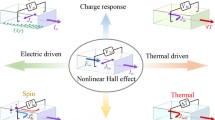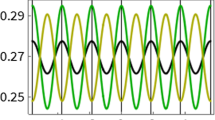We developed theory of the magnetic edge states in a half-plane of transition metal dichalcogenide monolayer. The main qualitative feature of such system that distinguishes it from an unbounded plane is “tau-splitting”; i.e., lifting of the valley degeneracy in an energy spectrum. Interband optical transitions are characterized by the violation of the selection rules established for the same transitions in an unbounded monolayer.



Similar content being viewed by others
REFERENCES
M. S. Khaikin, Sov. Phys. JETP 12, 152 (1961).
M. S. Khaikin, Sov. Phys. Usp. 11, 785 (1969).
T.-W. Nee and R. E. Prange, Technical Report No. 668 (Univ. Maryland, 1967).
T.-W. Nee and R. E. Prange, Phys. Lett. A 25, 582 (1967).
T.-W. Nee and R. E. Prange, Phys. Rev. 168, 779 (1968).
R. E. Prange, Phys. Rev. 171, 737 (1968).
T. W. Nee, J. F. Koch, and R. E. Prange, Phys. Rev. 174, 758 (1968).
B. I. Halperin, Phys. Rev. B 25, 2185 (1982).
A. H. Macdonald and P. Středa, Phys. Rev. B 29, 1616 (1984).
D. A. Abanin, P. A. Lee, and L. S. Levitov, Phys. Rev. Lett. 96, 176803 (2006).
M. I. Katsnelson, Graphene: Carbon in Two Dimensions (Cambridge Univ. Press, New York, 2012).
I. Bartoš and B. Rosenstein, Phys. A 27, 153 (1994).
J. P. Vigneron and M. Auslos, Phys. Rev. B 18, 1464 (1979).
D. Xiao, G.-B. Liu, W. Feng, X. Xu, and W. Yao, Phys. Rev. Lett. 108, 196802 (2012).
V. V. Enaldiev, Phys. Rev. B 96, 235429 (2017).
M. V. Berry and R. J. Mondragon, Proc. R. Soc. London, Ser. A 412, 53 (1987).
D. Oliveira, J. Fu, L. Villegas-Lelovsky, A. C. Dias, and F. Qu, Phys. Rev. B 93, 205422 (2016).
F. Qu, A. C. Dias, J. Fu, L. Villegas-Lelovsky, and D. L. Azevedo, Sci. Rep. 7, 41044 (2017).https://doi.org/10.1038/srep41044
F. Rose, M. O. Goerbig, and F. Piechon, Phys. Rev. B 88, 125438 (2013).
Author information
Authors and Affiliations
Corresponding author
Ethics declarations
The authors declare that they have no conflicts of interest.
APPENDIX
APPENDIX
Let us make, in Eq. (13), transformation \(E,\tau \to - E, - \tau \):
The energy spectrum corresponding to Eq. (10) consists of two bands: conduction band and valence band. We will consider Eq. (13) in the conduction band (i.e., for \(E > 0\)) and Eq. (13) in the valence band (i.e., for \(E < 0\)). Further, one can rewrite Eqs. (13) and (17) by explicitly introducing the band and valley indices:
Energies can be expressed in terms of q as \({{E}^{{({\text{c}},\tau )}}} = \) \(\sqrt {{{\Delta }^{2}}{\text{/}}4 + {{\Omega }^{2}}{{q}^{{({\text{c}},\tau )}}}} \) and \({{E}^{{({\text{v}},\tau )}}} = - \sqrt {{{\Delta }^{2}}{\text{/}}4 + {{\Omega }^{2}}{{q}^{{({\text{v}},\tau )}}}} \). Comparing Eq. (18) with Eq. (19) we see that there are relations \({{E}^{{({\text{v}},\tau )}}} = - {{E}^{{({\text{c}}, - \tau )}}}\) and \({{q}^{{({\text{v}},\tau )}}} = {{q}^{{({\text{c}}, - \tau )}}}\).
Rights and permissions
About this article
Cite this article
Chaplik, A.V., Magarill, L.I. & Vitlina, R.Z. Magnetic Edge States in Transition Metal Dichalcogenide Monolayers. Jetp Lett. 115, 620–625 (2022). https://doi.org/10.1134/S0021364022100563
Received:
Revised:
Accepted:
Published:
Issue Date:
DOI: https://doi.org/10.1134/S0021364022100563




